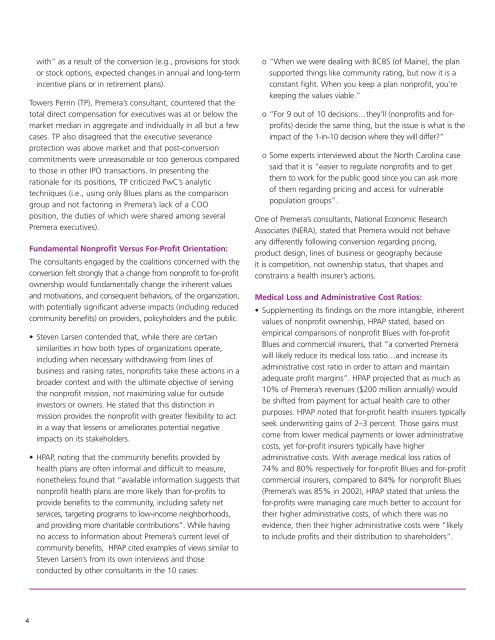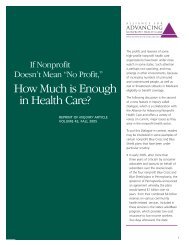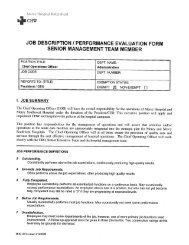Premera Blue Cross's Proposed Conversion to For-Profit Status
Premera Blue Cross's Proposed Conversion to For-Profit Status
Premera Blue Cross's Proposed Conversion to For-Profit Status
- No tags were found...
Create successful ePaper yourself
Turn your PDF publications into a flip-book with our unique Google optimized e-Paper software.
with” as a result of the conversion (e.g., provisions for s<strong>to</strong>ckor s<strong>to</strong>ck options, expected changes in annual and long-termincentive plans or in retirement plans).Towers Perrin (TP), <strong>Premera</strong>’s consultant, countered that the<strong>to</strong>tal direct compensation for executives was at or below themarket median in aggregate and individually in all but a fewcases. TP also disagreed that the executive severanceprotection was above market and that post-conversioncommitments were unreasonable or <strong>to</strong>o generous compared<strong>to</strong> those in other IPO transactions. In presenting therationale for its positions, TP criticized PwC’s analytictechniques (i.e., using only <strong>Blue</strong>s plans as the comparisongroup and not fac<strong>to</strong>ring in <strong>Premera</strong>’s lack of a COOposition, the duties of which were shared among several<strong>Premera</strong> executives).Fundamental Nonprofit Versus <strong>For</strong>-<strong>Profit</strong> Orientation:The consultants engaged by the coalitions concerned with theconversion felt strongly that a change from nonprofit <strong>to</strong> for-profi<strong>to</strong>wnership would fundamentally change the inherent valuesand motivations, and consequent behaviors, of the organization,with potentially significant adverse impacts (including reducedcommunity benefits) on providers, policyholders and the public.• Steven Larsen contended that, while there are certainsimilarities in how both types of organizations operate,including when necessary withdrawing from lines ofbusiness and raising rates, nonprofits take these actions in abroader context and with the ultimate objective of servingthe nonprofit mission, not maximizing value for outsideinves<strong>to</strong>rs or owners. He stated that this distinction inmission provides the nonprofit with greater flexibility <strong>to</strong> actin a way that lessens or ameliorates potential negativeimpacts on its stakeholders.• HPAP, noting that the community benefits provided byhealth plans are often informal and difficult <strong>to</strong> measure,nonetheless found that “available information suggests thatnonprofit health plans are more likely than for-profits <strong>to</strong>provide benefits <strong>to</strong> the community, including safety netservices, targeting programs <strong>to</strong> low-income neighborhoods,and providing more charitable contributions”. While havingno access <strong>to</strong> information about <strong>Premera</strong>’s current level ofcommunity benefits, HPAP cited examples of views similar <strong>to</strong>Steven Larsen’s from its own interviews and thoseconducted by other consultants in the 10 cases:o “When we were dealing with BCBS (of Maine), the plansupported things like community rating, but now it is aconstant fight. When you keep a plan nonprofit, you’rekeeping the values viable.”o “<strong>For</strong> 9 out of 10 decisions…they’ll (nonprofits and forprofits)decide the same thing, but the issue is what is theimpact of the 1-in-10 decision where they will differ?”o Some experts interviewed about the North Carolina casesaid that it is “easier <strong>to</strong> regulate nonprofits and <strong>to</strong> getthem <strong>to</strong> work for the public good since you can ask moreof them regarding pricing and access for vulnerablepopulation groups”.One of <strong>Premera</strong>’s consultants, National Economic ResearchAssociates (NERA), stated that <strong>Premera</strong> would not behaveany differently following conversion regarding pricing,product design, lines of business or geography becauseit is competition, not ownership status, that shapes andconstrains a health insurer’s actions.Medical Loss and Administrative Cost Ratios:• Supplementing its findings on the more intangible, inherentvalues of nonprofit ownership, HPAP stated, based onempirical comparisons of nonprofit <strong>Blue</strong>s with for-profit<strong>Blue</strong>s and commercial insurers, that “a converted <strong>Premera</strong>will likely reduce its medical loss ratio…and increase itsadministrative cost ratio in order <strong>to</strong> attain and maintainadequate profit margins”. HPAP projected that as much as10% of <strong>Premera</strong>’s revenues ($200 million annually) wouldbe shifted from payment for actual health care <strong>to</strong> otherpurposes. HPAP noted that for-profit health insurers typicallyseek underwriting gains of 2–3 percent. Those gains mustcome from lower medical payments or lower administrativecosts, yet for-profit insurers typically have higheradministrative costs. With average medical loss ratios of74% and 80% respectively for for-profit <strong>Blue</strong>s and for-profitcommercial insurers, compared <strong>to</strong> 84% for nonprofit <strong>Blue</strong>s(<strong>Premera</strong>’s was 85% in 2002), HPAP stated that unless thefor-profits were managing care much better <strong>to</strong> account fortheir higher administrative costs, of which there was noevidence, then their higher administrative costs were “likely<strong>to</strong> include profits and their distribution <strong>to</strong> shareholders”.4







